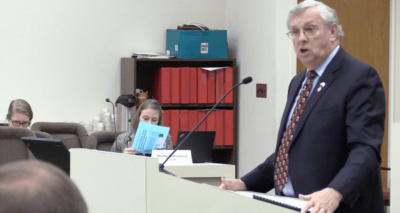A bill that loosens restrictions on class size requirements for grades K-3 passed the House unanimously yesterday.
House Bill 13 is a fix to lowered class sizes mandated for the grades by the General Assembly. The lower class sizes are scheduled to go into effect beginning in the 2017-18 school year.
Rep. Kevin Corbin, R-Macon, one of the lead sponsors of the bill, said it restores options on how to spend money to local districts.
“This bill would allow the small amount of flexibility that our schools have always enjoyed,” he said.
Rep. Chuck McGrady, R-Henderson, another lead author on the bill, said that the General Assembly has already fully funded districts so they can provide teachers to meet the class size requirements. However, those funds originally came with flexibility, so that districts could use the money for other purposes if they needed to.
He said the mandate put forward by the General Assembly in the last short session took that flexibility away. The sudden move has put districts in a bind, he said.
“Frankly they can’t adjust that quickly to the change that was made in that budget,” he said.
The General Assembly mandated requirement for class size allotment ratio is as follows:
Kindergarten: one teacher per 18 students
First grade: one teacher per 16 students
Second grade: one teacher per 17 students
Third grade: one teacher per 17 students
The strict limits left many schools needing more teachers and classrooms for smaller classes and wondering how they would pay for teachers for non-academic subjects like art, music, and physical education. Usually, school districts are allowed to maintain an average classroom size that is higher than the funded allotment. Districts traditionally use the excess funding in the classroom-teacher allotment from the state to hire “program enhancement teachers,” who typically teach non-core classes.
The class size mandate is also creating an issue for districts when it comes to facility requirements, according to some legislators who spoke on the bill during the House session. Rep. Sarah Stevens, R-Surry, said that providing the space for extra classrooms is the biggest concern she’s hearing from schools in her district.
“It’s not just about how education is funded, it was also about the physical space needed for these children,” she said.
McGrady said that in Henderson County, the district would have to buy more than 20 mobile units to create additional elementary classrooms. That would cost about $1 million and would come from the county. Counties pay for facility costs, not the state.
Rep. Gale Adcock, D-Wake, said that in talking to Wake County education officials, she heard that the class size restrictions would require $32 million over three years in local funds to pay for 400 additional elementary school classrooms. She also said the requirements would result in another $320 million in an “unfunded mandate to the Wake County taxpayers in both capital and operating expense.”
HB 13 allows school districts’ average classroom size to exceed the funded allotment ratio by three students. The maximum individual class size, if the bill becomes law, could exceed the funded allotment ratio by six students. A similar bill passed the House during the special session in December but wasn’t heard in the Senate.
While the entire House voted for the legislation Thursday, not everybody had positive things to say.
Rep. Darren Jackson, D-Wake, said that the General Assembly mandate had created a no-win situation where districts had to choose between higher class sizes and having to cut extracurricular activities for students.
“If you support public education, there is no good outcome on this yes/no vote,” he said. “So the question is how did the majority get us into this mess?”
He went on to say that Republicans had created the problem by choosing to use funds on things such as “tax giveaways,” rather than education.
He also said that for the past few weeks, the Republicans have been bragging about the state’s more-than $550 million surplus for this year, and that the surplus should be used to fund lower class sizes.
“If we truly believe that class size can make a difference…then we just fund it,” he said. “Make that commitment and follow through on it.”
Rep. William Brawley, R-Mecklenburg, tried to clarify with McGrady whether or not schools are already funded to have the teachers to support lower class size. McGrady said that they do already have that funding.
“When you are talking about flexibility, are you telling me that the school systems have taken money that we gave them to hire teachers to lower class sizes and are using it for other purposes?” Brawley asked.
McGrady said yes, with a caveat.
“It’s not necessarily a bad thing, because what we said also when we gave them the money for this, we told them that they would have the flexibility to make those decisions,” he said. “But yes, we funded what we said we wanted in the law.”
McGrady went on to say that the fact that local districts were utilizing flexibility in lieu of lowering class sizes led to Senate language in the short session that limited their flexibility.
“The Senate is upset that many of the school systems are using monies that were intended for class size reductions for other purposes,” he said. “And for that reason they pushed hard, successfully hard, to get a provision in that provided little flexibility for the LEAs (Local Education Agencies) to do that,” he said.
McGrady also said that legislators are starting to get frustrated that they’re not seeing class size reductions happen in grades K-3 across the state.
“I think LEAs, if they’re listening to this debate, would be well served to begin to move quickly to address the class size issue.”
The bill now moves on to the Senate.



